Perspectives on real opportunities and persisting obstacles
For Stephanie Newby (Millwright ’16) progress is represented by a stark contrast between the present and past. Since she started as a Millwright instructor in September 2021, she has had only one woman throughout all of her classes, which average about 20 people.
“That’s not too bad,” she says, “considering where we were years ago.”
This is not unusual. In Canada in 2022, women accounted for just 7.4% of the trades workforce (8.6% in Alberta). It’s better than 2001, when women accounted for 5.6% nationally (Alberta, 6.6%). But growth of less than 2% over 20 years doesn’t offer much to celebrate.
“There’s this gap that needs to be bridged,” says Newby.
“I don’t think it’s fair to say that with every avenue in life it’s going to be 50-50, men and women, but I think that such a staggering difference does say, ‘Well, there might be an issue here.’”
Cecile Bukmeier (Auto Body Technician ’15) has seen a growing number of women in her classes since she signed on as a NAIT auto body instructor in 2018 and recently took over on the role of program chair. It’s little wonder – the trades tend to offer rewarding, high-paying careers. But Bukmeier feels that “we’re at the very beginning of all this.
“I still get classes where it’s all men and they’ve never seen a woman in an auto body shop.”
Both Bukmeier and Newby use the word stigma to help explain the imbalance, but in different ways. Bukmeier sees it as the pressure that can be put on women to prove themselves on the job – a pressure she feels is not applied equally to men. “There’s this deeper fear in women that if they screw up they’re going to be out the door,” she says.
For Newby, the stigma applies to how people see the working environment. “A lot of people that I’ve spoken to have a similar perception: It’s a man’s world; it’s rough and tumble; you’ve got to be strong; you have to have thick skin. And it isn’t necessarily suited for a woman.”
The solution to overcoming either stigma is the same one that will put more women in both instructors’ shops. The trades need to show there is space for women to be auto body techs, millwrights, or as we’ll see with the women below, plumbers, machinists, electricians, mechanics and any other skilled trade that requires rigorous use of both body and mind.
And, Bukemeier and Newby add, women need to claim that space. They acknowledge that this requires being comfortable with being trailblazers. In addition to being assigned the tasks of the day, they're tacitly expected to do the emotional labour of clearing a path for others to follow.
“Be courageous, be curious,” says Newby. “Be motivated and inspired. And then be essential.”
Both instructors know they are leading by example. As an advocate for women in the trades, Bukmeier knows her job is to do more than just teach skills a tradesperson will need on the jobsite. It’s about understanding that the jobsite needs to change, and that men and women both have roles to play in that.
“I 100% believe that women belong anywhere men belong,” Bukmeier says. “The goal is [one day] not to have a need for a specific ‘women in trades’ initiative. It’s going to be just, ‘Hey, join the trade.’ Until it’s at that level, there’s going to be a need to show women that they can do these things.”
Join us for Next in Trades
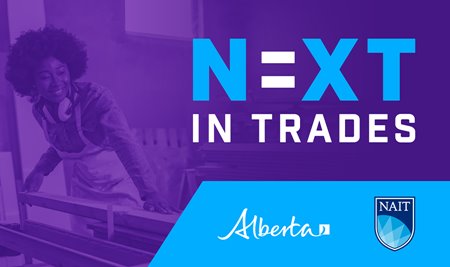
Next in Trades is a free event series that encourages and empowers people aged 16 and up from all backgrounds and abilities to explore careers in the skilled trades.
The March 18 event will feature hands-on workshops and panel discussion focused on lived experiences of Aboriginal peoples, Black and racialized communities, newcomers and refugees.
The March 25 event will focus on lived experiences of the 2SLGBTQIA+ community in the skilled trades.
Learn more and register
Solome Lwanga
Electrician, 4th year apprentice
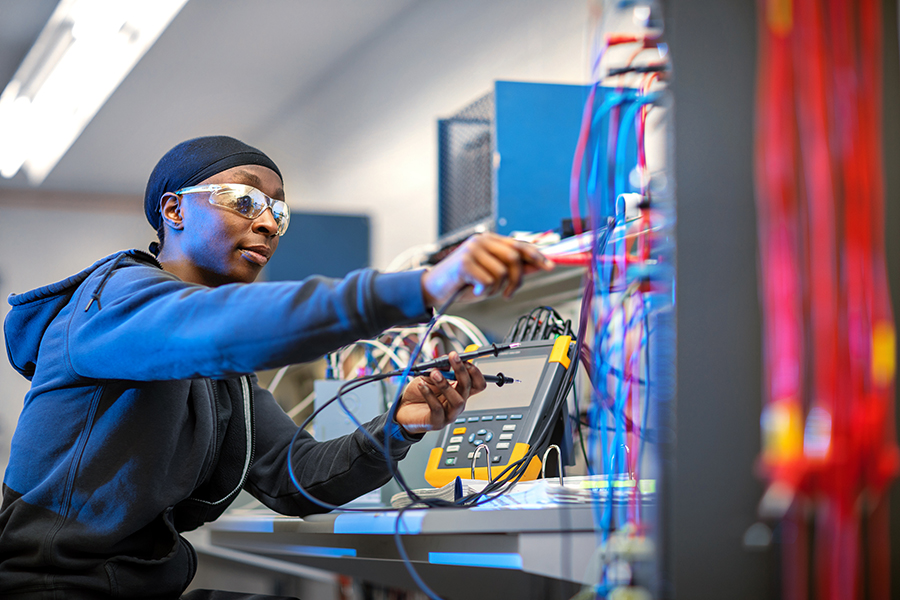
Solome Lwanga was attracted to becoming an electrician for how it brings the hands and mind together. You need to pull wire, bend pipe, connect breakers and so on, but also to understand the flow of electricity itself. “I think it’s interesting how power works and how it all comes together,” she says.
She also likes the way things come together differently from job to job. “There are just so many variations.”
Lwanga doesn’t let it get to her that her skills are sometimes underestimated when she first arrives at a job. She lets her work speak for her, but she’s also not afraid to speak for herself.
“You kind of have to come out with a voice,” says the 24-year-old.
“You make it or you break it – and I’m definitely making it."
“You make it or you break it – and I’m definitely making it. Working in an environment where I’m a minority and still be able to pull my weight is kind of self-congratulating. Not many people expect me to be able to work in the way that I can or be able to do what I do.
“People who tend to think that they know better will get put in their place by me, anyways,” Lwanga adds. “Either way, all the work will get done.”
Melanie Goudreau
Plumber (class of ’17)
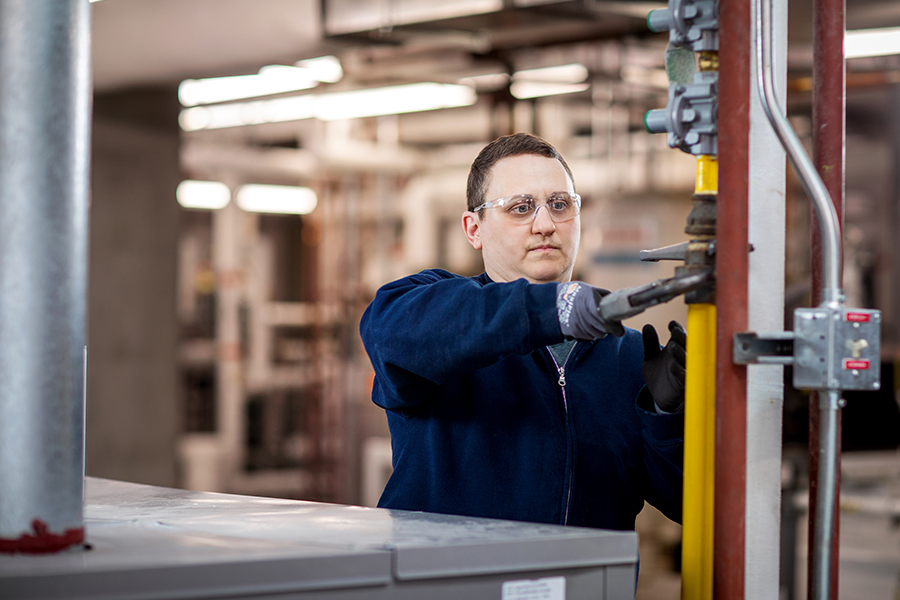
When Melanie Goudreau faced a career change in her thirties, she considered the trades for the first time in her life, starting with an introductory course at Women Building Futures. “I was like, what will make me be able to live a decent quality of life for the next 30 years?” says Goudreau.
After continuing her education through NAIT, the plumber is back on campus, this time as part of a maintenance crew. Goudreau repairs anything from a kitchen tap to switching out an eight-inch valve, and takes satisfaction from the troubleshooting to being able to step back and admire the outcome.
"What will make me be able to live a decent quality of life for the next 30 years?”
That’s not all that gives her satisfaction. During her time at NAIT, Goudreau encountered only one other woman in her classes over four years. Now that she’s on campus working, she feels that she is proof that other women can take advantage of the opportunity she sought years ago, when wondering how a career change might improve her life.
“I hope a student in the trades or anywhere sees me and says, ‘Hey, if she can do it, I can do it.’”
Tavia Heaven
Auto Body Technician, 2nd year apprentice
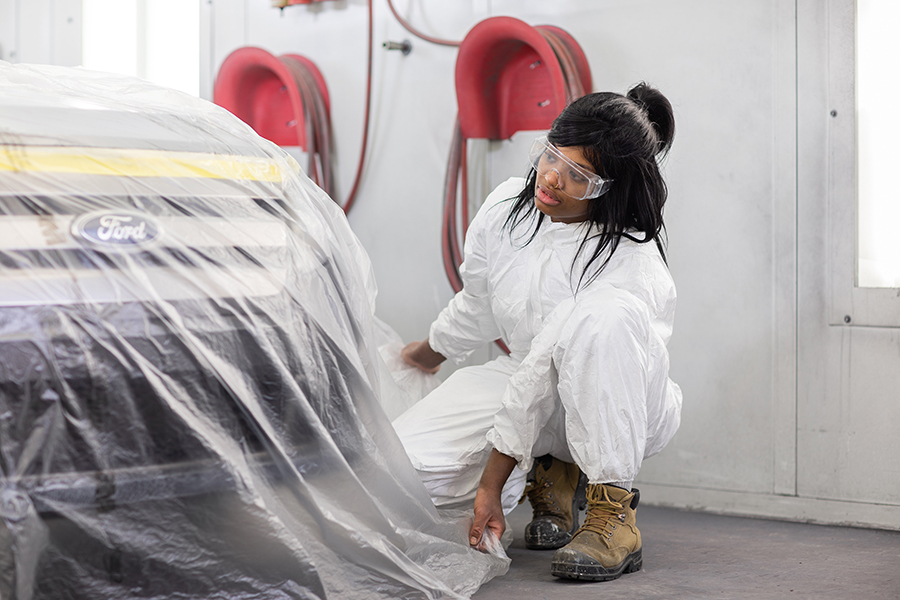
Ever since she played with cars with her brother when they were kids, Tavia Heaven has loved vehicles. “I love fixing them, taking them apart, putting them back together.”
In her work at an Edmonton auto body shop, she’s also discovered that she loves painting them.
“This is what I want to do. I just want to make the customer feel happy about their vehicle when it’s done.”
“It feels good everyday to tell people I can do this."
When Heaven was younger and considering the trade, encouragement was rare. “Guys told me I couldn’t do it,” she says.
Now that she’s proving she can make a career in the profession, disbelief isn’t the common reaction – though it’s not far removed.
“People ask me what I do for a living and they’re really shocked about it because I'm a girl,” says Heaven. “It feels good everyday to tell people I can do this.
“As long as you can do the job, that’s all that matters. You shouldn’t treat anybody different.”
Kara Clark
Heavy Equipment Technician apprentice, 2nd year (Automotive Services Technician ’14)
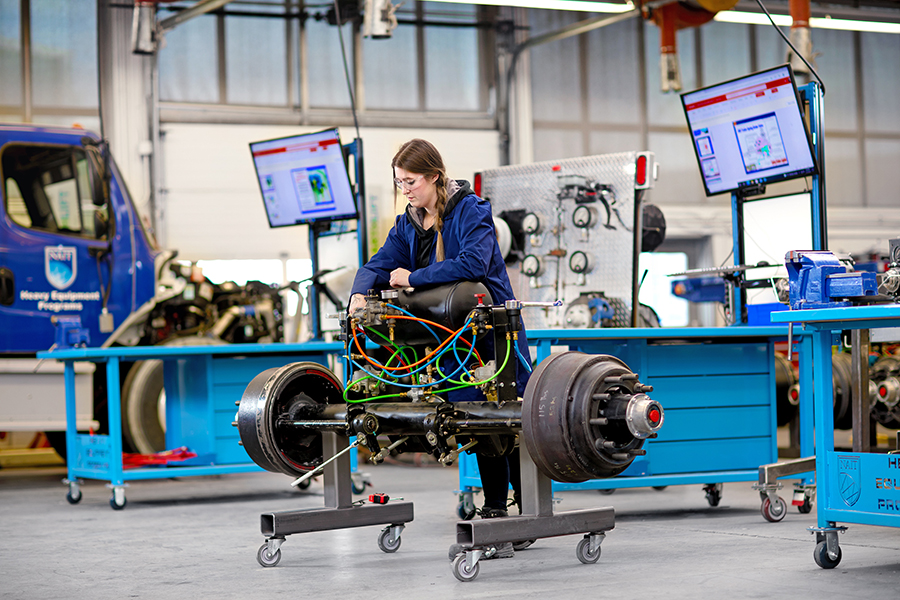
Kara Clark started in mining in Grande Cache when she was 18 years old, working through her automotive apprenticeship while servicing the vehicles that kept the mining operation going. Now 30, after sticking with the automotive trade in and around Edmonton, she’s pursuing a second ticket as a heavy equipment tech at a coal mine in Hinton.
Clark is the only woman on the maintenance crew, servicing equipment including shovels and haul trucks. The scale of the machinery challenges both body and mind.
“I’m definitely not as strong as men but that’s where you have to figure out ways that you can do it, or not be afraid to ask for help.”
Take haul truck brakes, for example. “The guys can manhandle them on and off; I can't. So I figured out a way to [use] rebar to slide them and use a crane.”
"I am not afraid to ask for help, but I will give it my 100% effort before I ask for help."
“I had one foreman who would tell me, ‘Use the girl card – just get the guys to do it.’ And I would say, ‘I am not afraid to ask for help, but I will give it my 100% effort before I ask for help.’”
It’s an approach that has served her well. The job pays well; she likes being part of the crew and working with the guys; she loves the week-on, week-off shift work (despite the 12-hour days).
“I just enjoy what I'm doing,” says Clark.
Cecile Bukmeier
Auto Body Technician instructor (class of ’15) and chair
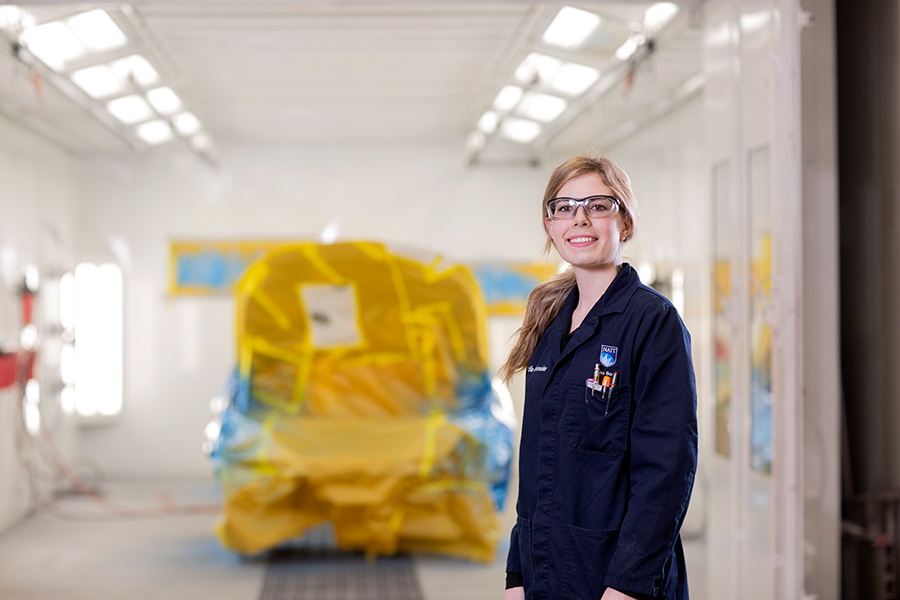
“It’s valuable to be in my position because I can show [men] that having a woman in the shop is no different than having a man in the shop,” says Cecile Bukmeier, the first female Auto Body Technician instructor in the 50-year history of the program at NAIT. She's now its first chair.
"Having a woman in the shop is no different than having a man in the shop.”
“Hopefully having me as their teacher gives them a more positive outlook on having women come into the shop. You can see that the perspective is starting to change.”
Karis Goodswimmer
CNC Machinist Technician, 1-year certificate
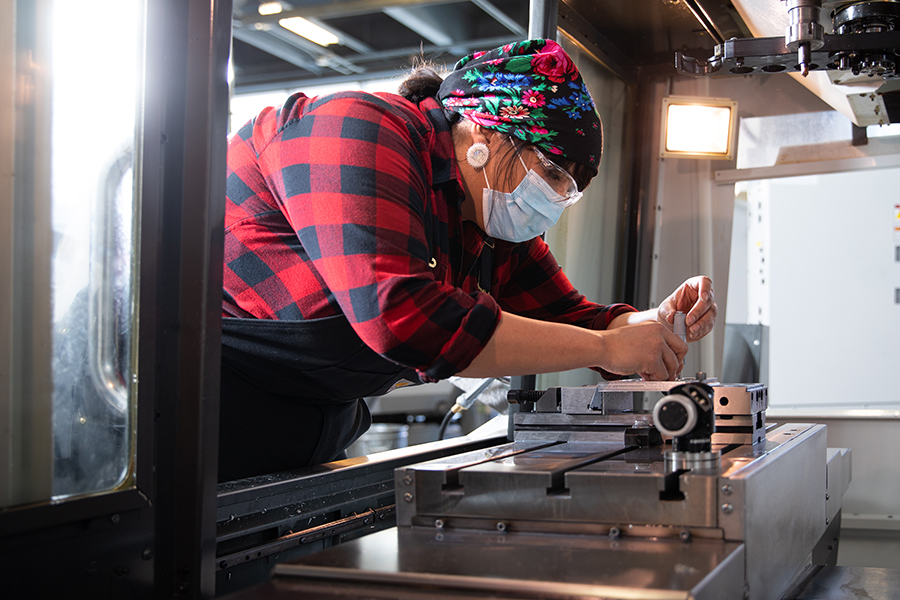
When Karis Goodswimmer moved from the Grande Prairie area to Edmonton in 2018, she applied for and landed a job in a machining shop. Having grown up in a houseful of mechanics and being technically minded, interested in both hands-on work and computer coding in high school, it struck her as a fit.
“That was my foot in the door," says Goodswimmer.
“There are so many cool things you can do with machining. Pretty much everything you use in everyday life is machined – car parts would be an example.”
“Being seen as a trailblazer is all I want to do.”
Goodswimmer is the only Indigenous woman in her program, a one-year certificate that allowed her to start her training and potentially challenge her first-year apprenticeship exam. Growing up in Grande Prairie, a region with high oil and gas activity, she feels she wasn’t made aware of the myriad ways to participate in local industry.
“Millwright, machinist – all those kinds of trades? You don’t really hear about that,” she says.
If she had her way, she’d make sure members of Indigenous communities in particular knew about and had access to opportunities similar to what she’s pursuing. She’d also find ways to make them feel at home in labs and classrooms.
“I want to make sure it is a more comfortable environment for them, because I would understand how it feels.”
In the meantime, she’ll work to finish her certificate so she can transition from labourer to operator at her current job, knowing that, as she does so, she’s raising awareness that women, and Indigenous women in particular, have a place in the trade.
“I think representation is key,” says Goodswimmer. “Being seen as a trailblazer is all I want to do.”
Stephanie Newby
Millwright instructor (class of ’16)
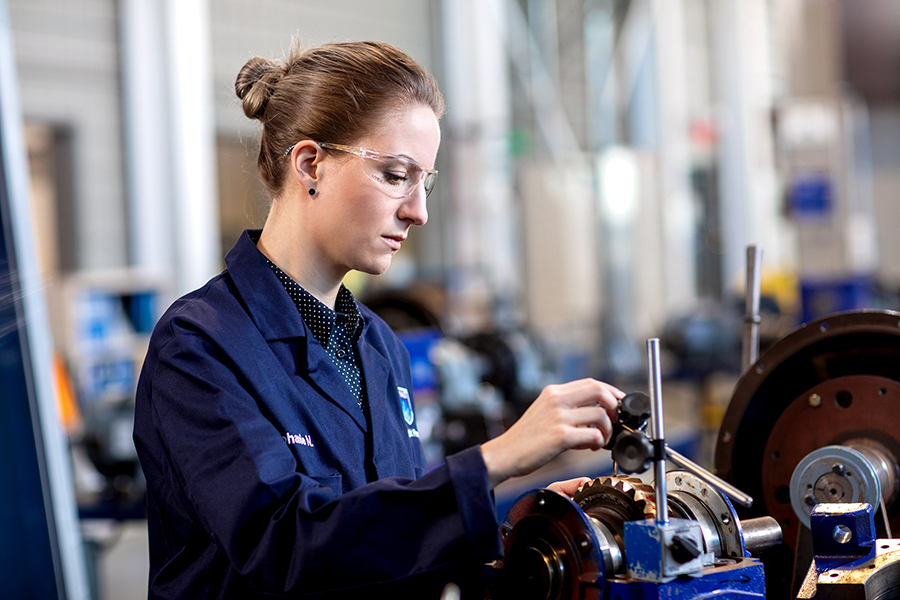
Stephanie Newby looks to her lone female student with a unique hope.
“I hope that the next time she encounters a hurdle because of her gender, she's able to jump over it and not be overwhelmed by it, or feel like she can’t do it – or like she’s a failure because she has half-a-dozen guys cat calling her or thinking she can’t do something. And that is more common than I think most people will admit.
“It’s still part of that stigma and part of the problem.”
It takes courage to have the hard conversation about persisting challenges, says Newby, but doing so can make a difference in people’s lives.
“There were people who were open-minded and gracious enough to give me a shot,” she says. “I’m young, I don’t exactly fit the bill for the majority of people who are involved in this. But somebody gave me a chance, a real chance.
“And I'm grateful enough to be here to pursue my passion, that passion being to nourish me but also nourish others, [to] give them the tools they need to succeed. That’s why I get up in the morning and I’m happy to start the day, because I feel like I have this responsibility and this responsibility means something.”